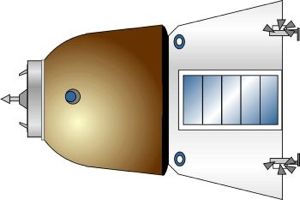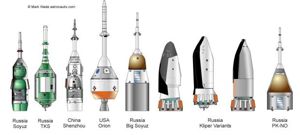
Home - Search - Browse - Alphabetic Index: 0- 1- 2- 3- 4- 5- 6- 7- 8- 9
A- B- C- D- E- F- G- H- I- J- K- L- M- N- O- P- Q- R- S- T- U- V- W- X- Y- Z
Big Soyuz
 Big Soyuz Credit: © Mark Wade |
Status: Study 2008. Payload: 3,300 kg (7,200 lb). Gross mass: 11,000 kg (24,000 lb). Height: 6.60 m (21.60 ft). Diameter: 3.30 m (10.80 ft).
It was favored neither by RKK Energia (which favored the Kliper design) or by the Russian Space Agency (which preferred the PK conical reentry vehicle shape).
An enlarged version of the proven Soyuz re-entry vehicle shape, to accommodate six rather than three crew, could be considered a logical follow-on to the Soyuz itself. A similar design was in an advanced stage of design in the late 1980's as the Zarya and considered again in the 1990's as the Alpha Lifeboat for the ISS. But the design was found inferior to both the Kliper lifting-body design of RKK Energia and the Khrunichev conical re-entry vehicle favored by the Russian Space Agency. Although at 11 metric tons it had the lowest mass of any of the other designs, the Big Soyuz concept would subject the crew to 4.2 G's during normal ascents to orbit and 5 G's on re-entries. The crew would pull12 G's in an emergency abort during the launch phase.
The spacecraft would be placed in a 135 km x 440 km, 51.6 deg orbit on the baseline mission to the ISS. Its on-board propulsion system would bring it to a rendezvous and docking with the station. The capsule provided a total of 12 cubic meters of habitable volume, or 2 cubic meters per crew member.
The capsule provided sufficient lift for a cross-range only 75 km to either side of the ballistic re-entry landing point, and 400 km along the orbital track. This meant it could return the crew to Russian territory on only 1 or 2 orbits per day. Landing precision was within 11 kilometers of the aim point, and 70% of the capsule could be reused after a mission.
The baseline spacecraft would meet the Russian Space Agency's basic requirements which were as follows:
- Crew of six with 500 kg of payload; or two with 1,000 kg of internal payload
- Capable of 14 days of autonomous flight with full crew, and one year of on-orbit storage when docked to a space station
- Provisions for crew rescue from the moment of launch to recovery. This meant an abort tower for the early launch phase, and a reserve parachute for recovery, but not ejection seats or orbital bail-out pods.
- Designed probability of returning the crew safely to earth of 99.9%
- Minimal preparation time to allow prompt evacuation of crew members to earth in medical emergencies
- Maximum G-forces in a launch abort of 14 G's, 5 G's during normal ascent to and return from orbit, and 12 G's during an emergency ballistic reentry
- Normal launch and recovery from the territory of Russia (this would require launch from the new Vostochniy Cosmodrome instead of Baikonur).
- Minimal development and production cost
- Operational no later than 2018
- Production life 30 to 40 years
- Landing accuracy of less than 15 km from aim point
- At least 2 cubic meters habitable volume per crew member (e.g. 12 cubic meters habitable volume total)
- Environmentally safe propellants (e.g. not nitrogen tetroxide/hydrazine, but rather oxygen/kerosene or similar)
- No debris left in orbit after mission
Crew Size: 6. Orbital Storage: 365 days. Habitable Volume: 12.00 m3.
Family: Manned spacecraft, New Generation Crewed. Country: Russia. Agency: Korolev bureau, RAKA.
 | New Generation Manned Spacecraft Credit: © Mark Wade |
 | New Generation Launch Escape Systems of New Generation Manned Spacecraft Credit: © Mark Wade |
Back to top of page
Home - Search - Browse - Alphabetic Index: 0- 1- 2- 3- 4- 5- 6- 7- 8- 9
A- B- C- D- E- F- G- H- I- J- K- L- M- N- O- P- Q- R- S- T- U- V- W- X- Y- Z
© 1997-2019 Mark Wade - Contact
© / Conditions for Use